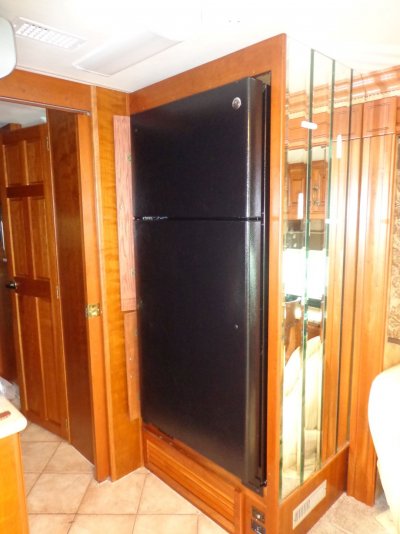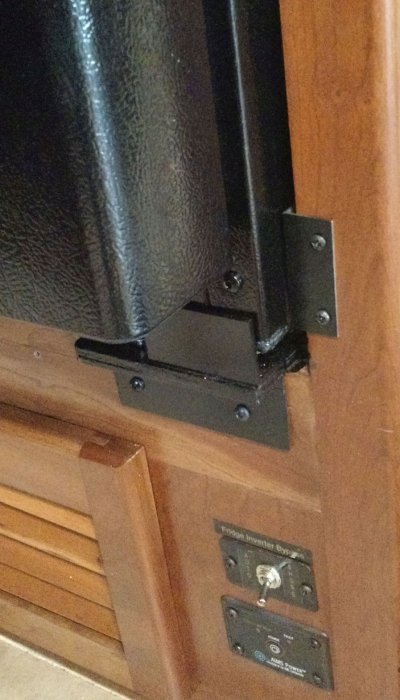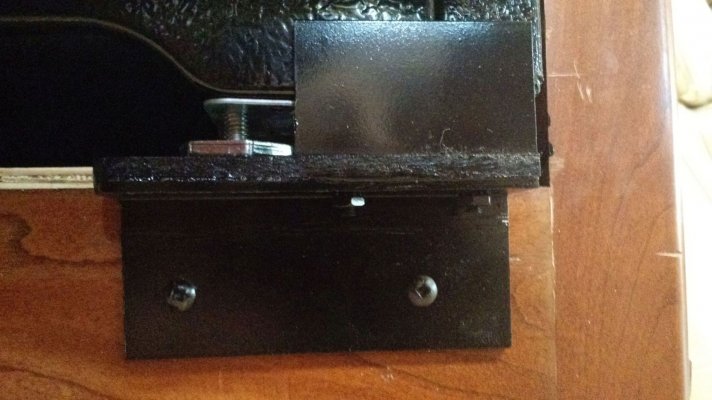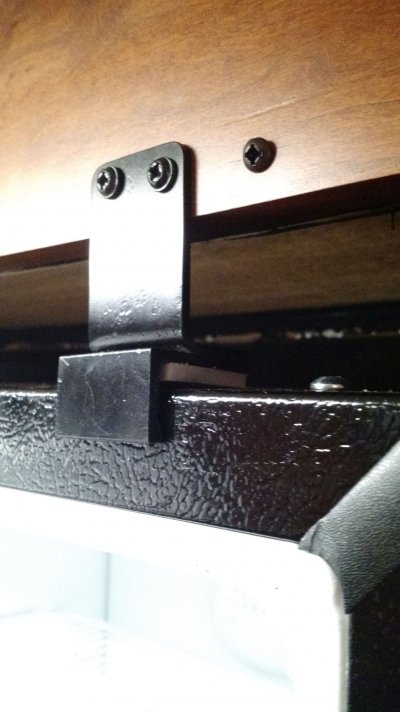You are using an out of date browser. It may not display this or other websites correctly.
You should upgrade or use an alternative browser.
You should upgrade or use an alternative browser.
Out wth the old, in with the new!
- Thread starter Gary RV_Wizard
- Start date
The friendliest place on the web for anyone with an RV or an interest in RVing!
If you have answers, please help by responding to the unanswered posts.
If you have answers, please help by responding to the unanswered posts.
Larry N.
Well-known member
Looks great!
Gary RV_Wizard
Site Team
I will, but they tend to be unique to the particular install. I'll get some photos later today.
Gary RV_Wizard
Site Team
In response to a request about the retainer brackets...
I made brackets from 1/8" aluminum angle and bar stock. Easy enough to work with common tools, basically a hack saw, a vice, and file and/or sandpaper to smooth rough edges. One bracket is bolted together while the other is pop-riveted.
The bottom of the fridge case (not including doors) sticks out beyond the cabinet about 2/4", so I have a L-shaped 1.25" angle bracket screwed to the cabinet face to provide a slight extension on each side. Another 1"x1.5" angle bracket is bolted to that, with the the upward side pressing against the bottom front edge of the fridge, to prevent it from sliding out of the cabinet. The bottom of the fridge also has adjustable feet that push down against the bottom of the cabinet, further inhibiting movement (as well as adjusting for tilt). See Lower bracket photos below.
The top of the fridge has two similar brackets, A 1"x 1.5" angle lays against the top-forward edge of the freezer case and that angle is riveted to a vertical "L" bar. The vertical screws into the cabinet face above the fridge. The two piece construction allowed me to compensate for the 3/4" offset from cabinet face to the front of the fridge case. See Top bracket photo.
On either side of the fridge I placed another angle bracket to prevent the fridge from sliding sideways (forward/backward in terms of the coach orientation). Just the L, with one flange screwed into the cabinet face.
The door "keepers" that assure the doors won't swing open during travel are really simple: just screw eyes in the adjacent cabinet frame and adjustable flat bungee cords we slip into the eyes when needed.
The fairly simple attachment was made possible because the cabinetry is solid cherry and face-frame construction, so it holds screws decently. If it had been MDF or other composite material, it would have been necessary to bolt through the face to have enough strength.
I made brackets from 1/8" aluminum angle and bar stock. Easy enough to work with common tools, basically a hack saw, a vice, and file and/or sandpaper to smooth rough edges. One bracket is bolted together while the other is pop-riveted.
The bottom of the fridge case (not including doors) sticks out beyond the cabinet about 2/4", so I have a L-shaped 1.25" angle bracket screwed to the cabinet face to provide a slight extension on each side. Another 1"x1.5" angle bracket is bolted to that, with the the upward side pressing against the bottom front edge of the fridge, to prevent it from sliding out of the cabinet. The bottom of the fridge also has adjustable feet that push down against the bottom of the cabinet, further inhibiting movement (as well as adjusting for tilt). See Lower bracket photos below.
The top of the fridge has two similar brackets, A 1"x 1.5" angle lays against the top-forward edge of the freezer case and that angle is riveted to a vertical "L" bar. The vertical screws into the cabinet face above the fridge. The two piece construction allowed me to compensate for the 3/4" offset from cabinet face to the front of the fridge case. See Top bracket photo.
On either side of the fridge I placed another angle bracket to prevent the fridge from sliding sideways (forward/backward in terms of the coach orientation). Just the L, with one flange screwed into the cabinet face.
The door "keepers" that assure the doors won't swing open during travel are really simple: just screw eyes in the adjacent cabinet frame and adjustable flat bungee cords we slip into the eyes when needed.
The fairly simple attachment was made possible because the cabinetry is solid cherry and face-frame construction, so it holds screws decently. If it had been MDF or other composite material, it would have been necessary to bolt through the face to have enough strength.
Attachments
SargeW
Site Team
Nice work Gary, barley noticeable!
Gary RV_Wizard
Site Team
Since I took the top bracket photo, I've added a decorative trim (aluminum panel perforated with 4-leaf clover pattern) along the top edge, so the retainers are even less noticeable. I wanted to cover the fairly large hole at the top, yet still retain the air flow the fridge needs to function well.
I did not put any trim at the sides, preferring to leave a 3/4" gap to provide ventilation there as well.
I did not put any trim at the sides, preferring to leave a 3/4" gap to provide ventilation there as well.
WILDEBILL308
Well-known member
Great job!
Bill
Bill
Gary RV_Wizard
Site Team
Thanks!
I ran an inverter load test yesterday and the 1000W Aims does a fine job. The 4 gauge battery cables were plenty (they are about 4 ft long).
The fridge appears to draw only about 1.5-2.0A when running, despite its 6.5A spec rating. Wish I had used my Kill-O-Watt to measure it before placing in the wall, but it's too late now! That would mean a battery draw in the 20A range and my 4x Trojan 31AGMs can handle that for hours.
I ran an inverter load test yesterday and the 1000W Aims does a fine job. The 4 gauge battery cables were plenty (they are about 4 ft long).
The fridge appears to draw only about 1.5-2.0A when running, despite its 6.5A spec rating. Wish I had used my Kill-O-Watt to measure it before placing in the wall, but it's too late now! That would mean a battery draw in the 20A range and my 4x Trojan 31AGMs can handle that for hours.
SargeW
Site Team
Great news Gary!
Gary RV_Wizard
Site Team
Indeed! We are rarely off-grid anymore, but the fridge would be no problem if we choose or are forced to do so.
So far I am quite impressed with this GE's performance. At its warmest setting is is keeping the fridge between 28 and 36, and the freezer between -5 & +5, and it doesn't run much at all.
So far I am quite impressed with this GE's performance. At its warmest setting is is keeping the fridge between 28 and 36, and the freezer between -5 & +5, and it doesn't run much at all.
boatbuilder
Well-known member
Looks good Gary. Looks just like the brackets we used to make for the boats.
Gary RV_Wizard
Site Team
You can probably get through one night with the two T105's. Depending on your other power uses, of course. Probably you would want to run your genset to fully charge in the evening, then plan on running it again in the morning. And not for just 15 minutes either. More like two hours, in fact.
Personally I would want at least 50% more battery amp-hours than that if I expected to boondock at all.
Personally I would want at least 50% more battery amp-hours than that if I expected to boondock at all.
thanks Gary ... that's about what I was thinking also.
Daughter has our previous Mirada (1999) and frig went out ... most of the time it will be in a seasonal campground with hookups, but at least this year a planned trip to Oshkosh for the EAA flyin. That will be a week of dry camping on the airport using the generator.
So sorting the options ...
thanks !
Howard
Daughter has our previous Mirada (1999) and frig went out ... most of the time it will be in a seasonal campground with hookups, but at least this year a planned trip to Oshkosh for the EAA flyin. That will be a week of dry camping on the airport using the generator.
So sorting the options ...
thanks !
Howard
Lou Schneider
Site Team
- Joined
- Mar 14, 2005
- Posts
- 13,333
Gary RV Roamer said:The fridge appears to draw only about 1.5-2.0A when running, despite its 6.5A spec rating. Wish I had used my Kill-O-Watt to measure it before placing in the wall, but it's too late now! That would mean a battery draw in the 20A range and my 4x Trojan 31AGMs can handle that for hours.
The extra 500 watts is probably for the defrost cycle heating element. You'll have to figure out how long and how often the cycle runs to come up with the total power consumption.
I've thought about putting an on/off switch on the cycle timer so I could make the defrost cycle happen while the generator is running instead of having it defrost while running on the batteries. Haven't gotten around to it yet.
Gary RV_Wizard
Site Team
Yeah, I think you are probably right, Lou. I recall somewhere it says the defrost cycle is something like 13 hours.
The Energy Star data says the average annual power consumption is 347 kwh, so less than 1 kwh per day (under the lab test conditions, of course).
The Energy Star data says the average annual power consumption is 347 kwh, so less than 1 kwh per day (under the lab test conditions, of course).
Gary RV Roamer said:Thanks!
I ran an inverter load test yesterday and the 1000W Aims does a fine job. The 4 gauge battery cables were plenty (they are about 4 ft long).
The fridge appears to draw only about 1.5-2.0A when running, despite its 6.5A spec rating. Wish I had used my Kill-O-Watt to measure it before placing in the wall, but it's too late now! That would mean a battery draw in the 20A range and my 4x Trojan 31AGMs can handle that for hours.
And our Samsung runs the compressor less than 50% of the time unless we have the door open a lot.
8Muddypaws
Well-known member
Someone should make one that allows the owner to disable the defrost cycle entirely.
Lou Schneider
Site Team
- Joined
- Mar 14, 2005
- Posts
- 13,333
Won't work for a "typical" owner. A frost-free freezer doesn't directly cool by putting the cooling coils on a plate inside the freezer, instead there's a relatively small radiator that creates cold air. A fan blows the cold air to the rest of the freezer. Moisture condenses on the radiator, out of sight, and has to be melted before it significantly reduces the airflow.
When my defrost heater on my Mom's refrigerator went out, she didn't notice anything wrong until the freezer stopped cooling. At that point the ice completely plugged the radiator and it took several minutes carefully applying heat with a heat gun before I could remove the plastic cover. Then I spent the better part of an hour with the gun melting the supercooled ice block before I could access the heating element to replace it.
You might be able to delay one defrost cycle, but anything more than that is asking for trouble.
When my defrost heater on my Mom's refrigerator went out, she didn't notice anything wrong until the freezer stopped cooling. At that point the ice completely plugged the radiator and it took several minutes carefully applying heat with a heat gun before I could remove the plastic cover. Then I spent the better part of an hour with the gun melting the supercooled ice block before I could access the heating element to replace it.
You might be able to delay one defrost cycle, but anything more than that is asking for trouble.




